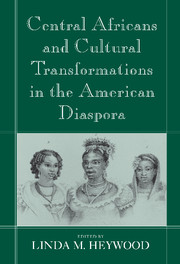Book contents
- Frontmatter
- Contents
- List of Contributors
- Foreword
- Acknowledgments
- Introduction
- PART ONE CENTRAL AFRICA: SOCIETY, CULTURE, AND THE SLAVE TRADE
- 1 Central Africa During the Era of the Slave Trade, c. 1490s–1850s
- 2 Religious and Ceremonial Life in the Kongo and Mbundu Areas, 1500–1700
- 3 Portuguese into African: The Eighteenth-Century Central African Background to Atlantic Creole Cultures
- PART TWO CENTRAL AFRICANS IN BRAZIL
- PART THREE CENTRAL AFRICANS IN HAITI AND SPANISH AMERICA
- PART FOUR CENTRAL AFRICANS IN NORTH AMERICA AND THE CARIBBEAN
- Index
1 - Central Africa During the Era of the Slave Trade, c. 1490s–1850s
Published online by Cambridge University Press: 28 October 2009
- Frontmatter
- Contents
- List of Contributors
- Foreword
- Acknowledgments
- Introduction
- PART ONE CENTRAL AFRICA: SOCIETY, CULTURE, AND THE SLAVE TRADE
- 1 Central Africa During the Era of the Slave Trade, c. 1490s–1850s
- 2 Religious and Ceremonial Life in the Kongo and Mbundu Areas, 1500–1700
- 3 Portuguese into African: The Eighteenth-Century Central African Background to Atlantic Creole Cultures
- PART TWO CENTRAL AFRICANS IN BRAZIL
- PART THREE CENTRAL AFRICANS IN HAITI AND SPANISH AMERICA
- PART FOUR CENTRAL AFRICANS IN NORTH AMERICA AND THE CARIBBEAN
- Index
Summary
Understanding the Central Africans who reached the New World as slaves requires consideration of at least four phases in their disrupted lives: (1) how the Bantu-language-speaking people living in Africa south of the Equator thought about themselves and the many local worlds they lived in, from the sixteenth through the midnineteenth centuries, (2) how those captured coped with removal from their home communities, the hardships of being marched into unknown coastlands and eventually loaded onto ships, and the trauma of the oceanic Middle Passage, and (3) how they might have remembered and drawn on these experiences once forcibly resettled in Spanish mainland colonies, in Brazil, in the West Indies, and in North America, depending (4) on what from their former lives in Africa they recognized as relevant to forging new senses of community in the Americas, with others of different backgrounds enslaved alongside them, under specific challenges of surviving that varied enormously throughout the continents and over the centuries.
This paper draws on the growing secondary literature on Central Africa during those times to historicize – as far as current knowledge permits – the first two of these abrupt transitions in the lives of the Central Africans enslaved. Historians are now specifying with increasingly useful precision the rapidly changing African contexts of time and place that they experienced during the more than 350 years that elapsed between the first, sixteenth-century shipments of African men and women abroad as slaves and the end of systematic transport of youthful captives after 1860.
- Type
- Chapter
- Information
- Publisher: Cambridge University PressPrint publication year: 2001
- 4
- Cited by



